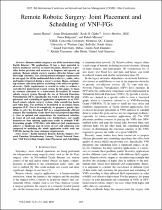| dc.contributor.author | Glitho, Roch H. | |
| dc.contributor.author | Hentati, Amina | |
| dc.contributor.author | Ebrahimzadeh, Amin | |
| dc.contributor.author | Belqasmi, Fatna | |
| dc.contributor.author | Mizouni, Rabeb | |
| dc.date.accessioned | 2023-04-14T11:31:37Z | |
| dc.date.available | 2023-04-14T11:31:37Z | |
| dc.date.issued | 2022 | |
| dc.identifier.citation | A. Hentati, A. Ebrahimzadeh, R. H. Glitho, F. Belqasmi and R. Mizouni, "Remote Robotic Surgery: Joint Placement and Scheduling of VNF-FGs," 2022 18th International Conference on Network and Service Management (CNSM), Thessaloniki, Greece, 2022, pp. 205-211, doi: 10.23919/CNSM55787.2022.9964591 | en_US |
| dc.identifier.uri | http://hdl.handle.net/10566/8798 | |
| dc.description.abstract | Remote robotic surgery is one of the most interesting Tactile Internet (TI) applications. It has a huge potential to deliver healthcare services to remote locations. Moreover, it provides better precision and accuracy to diagnose and operate on patients. Remote robotic surgery requires ultra-low latency and ultra-high reliability. The aforementioned stringent requirements do not apply for all the multimodal data traffic (i.e., audio, video, and haptic) triggered during a surgery session. Hence, customizing resource allocation policies according to the different quality-of-service (QoS) requirements is crucial in order to achieve a cost-effective deployment of such system. In this paper, we focus on resource allocation in a softwarized 5G-enabled TI remote robotic surgery system through the use of Network Functions Virtualization (NFV). Specifically, this work is devoted to the joint placement and scheduling of application components in an NFV-based remote robotic surgery system, while considering haptic and video data. The problem is formulated as an integer linear program (ILP). Due to its complexity, we propose a greedy algorithm to solve the developed ILP in a computationally efficient manner. The simulation results show that our proposed algorithm is close to optimal and outperforms the benchmark solutions in terms of cost and admission rate. Furthermore, our results demonstrate that splitting application traffic to multiple VNF-forwarding graphs (VNF-FGs) with different QoS requirements achieves a significant gain in terms of cost and admission rate compared to modeling the whole application traffic with one VNF-FG having the most stringent requirements.
URL: https://ieeexplore.ieee.org/stamp/stamp.jsp?tp=&arnumber=9964591&isnumber=9964490 | en_US |
| dc.language.iso | en_US | en_US |
| dc.publisher | IFIP | en_US |
| dc.subject | remote robotic surgery | en_US |
| dc.subject | joint placement | en_US |
| dc.subject | scheduling of VNF-FGs | en_US |
| dc.title | Remote robotic surgery: joint placement and scheduling of vnf-fgs | en_US |
| dc.type | Article | en_US |

